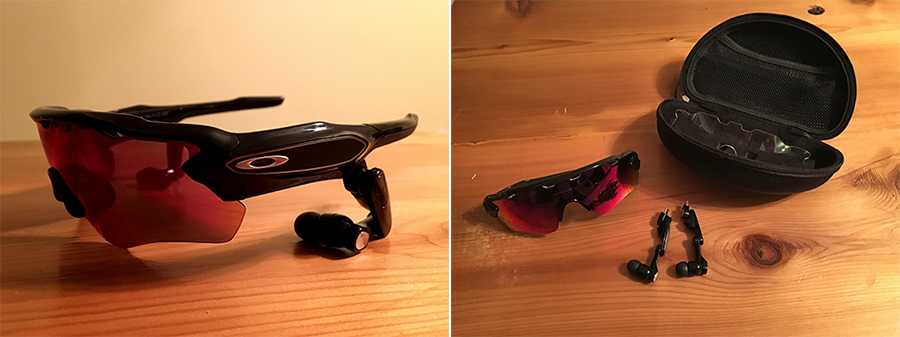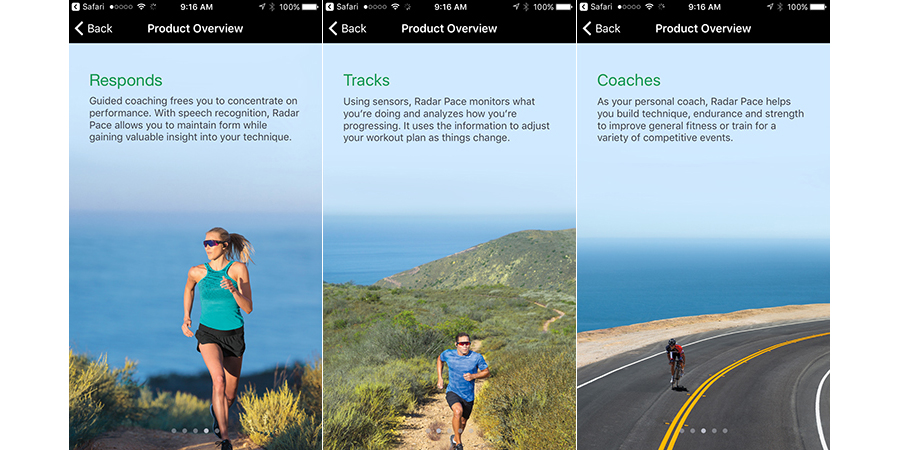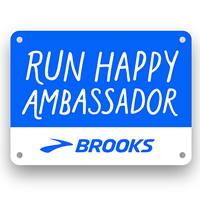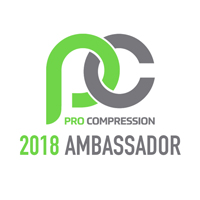This is a sponsored post with Runner’s World and Oakley.
I spent the better part of 2015 getting used to running without music in my ears. Often times I would find myself in the middle of a race annoyed by the music I was listening to—that may say more about my playlist selection in truth. But there are times, even today, where I wish I had something to break up the monotony of a long run.
We’re used to having real-time stats on our wrist, but recently there have been some new integrations into what runner’s hear in their ears. Apps are now delivering feedback through audio from pace to distance to cadence all the way to in-the-moment coaching—guiding you through a particular workout. When Runner’s World asked me to give the new Oakley Radar Pace a try, I was a little hesitant because I rarely run with something in my ears, but I remembered going though speed workouts last year and forgetting what my next distance or split was supposed to be. Perhaps having a coach deliver audio instructions would be easier than stopping to look at a piece of paper or hoping the workout written in ink on my wrist doesn’t wash away from sweat.
What is Radar Pace?
The short story is that they are bluetooth EarPods build into Oakley glasses. Using Intel technology it pairs with an app on your phone that can deliver a real-time voice-activated coaching system (they can also play music, too!) It can also pair with other external sensors to track power output, HR, speed, cadence, distance, time, all the essential things we are used to seeing on our wrist.
There is a built-in touch pad on the temples (of the glasses) for control functions, removing the mess of chords or buttons. It’s water resistant, microphone enabled, and even comes with various lenses if you happen to need them.
Click here to learn more about Oakley Radar Pace
My Experience
I have a couple of pairs of Oakley glasses that I run with, so integrating eyewear into my routine was pretty straight-forward. The EarPods connect (and disconnect if you want to run with just the glasses) just above the ear and have an adjustment arm to fit comfortably into the ear. There are microphones built in that allows the glasses to respond to commands like “OK Radar, what’s today’s workout” or “OK Radar, what’s my current pace/distance.” There were a couple of times I had to repeat myself early on, but after a few miles I was able to ask Radar questions pretty easily.
My first run was just listening to music. I wanted to get used to playing with the controls mid-run to see how easy it would be to increase the volume, pause, or skip to the next song. Again, like the above it took a couple of minutes for me to get used to the gestures and how sensitive the touch pad was, but the learning curve was small and I got the hang of it in no time. Think simple swipe gestures such as a forward swipe to skip a song. The sound quality was decent, but I prefer to hear some of the atmosphere and environment around me while I run so I didn’t have them fully inserted into my ear the majority of the time.
Real-Time Coaching
After inputting my stats into the app, and playing with a couple of different programs, I decided to go on a hill run for my first coached workout. The coach was able to let me know how much I needed to climb initially, as well as let me know how much “more” I needed to climb during my workout. It would also update me on pace/distance occasionally. I could also ask if I was ever curious—which I did for fun just because. I am so used to looking down at my watch, but I could see the benefit of not having to take your eyes off of the road to get real-time updates—this may be huge advantage for cyclists.
My second workout was a simple “free run.” The funny thing is that since I had already ran THAT day, the coach told me about the benefits of rest and recovery—it knows me too well. The coach is also able to implement dynamic adjustment to your routine if you happen to miss a work out as well as allow you customize your training plan based on goals (fitness vs. competition).
Various Workout Options
There are several built-in programs through the app. You can choose a workout based on goals, such as technique or speed. You can also start a training cycle based on desired outcome: competitive vs. improved fitness. I didn’t get a chance to dive deeply into any of the workout programs, but having an app track your entire training program and deliver real-time coaching could be useful in a one-stop shop kind of way.
Luxury
For me, this product falls under the “luxury” category of accessories. I think there is a definite benefit to having real-time feedback and being able to analyze your entire training program in a single place, but I don’t see this as something that a novice runner would try or need when they first start running or training. This almost feels like an additional piece that an experienced runner would add-in or purchase try to mix things up. I see myself using it occasionally for speed workouts, or hill workouts, but not exclusively for a training cycle.
At a price tag of $449, it’s not something that will be for everyone, but there is an audience for those looking for this type of product. We have seen the direction that wearable technology is going and the innovation that is happening with what used to be run-of-the-mill accessories (pun totally intended).
Stranger Things
I just wrote a post on a pair of sunglasses that track what you are currently doing, supposed to be doing, and delivers real-time feedback and coaching, uses voice-activated technology with a touch pad on the side… and oh ya, plays music and answers phone calls if you want it to. When I started training for a my first marathon, I had knee-length shorts and basketball shoes. Several months later when I bought a GPS watch that tracked my distance, I thought that was as super-high tech as you could be.
I wonder where we’ll be in the next couple of years.
What is the next piece of running technology that we might see?
This is a sponsored post with Runner’s World and Oakley.














